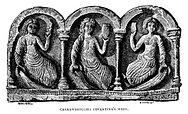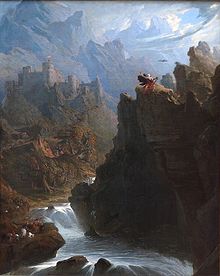Bard
| Part of a series on |
| Celtic mythology |
|---|
 |
|
Gaelic mythology |
|
Brythonic mythology |
|
Concepts |
|
Religious vocations |
|
Festivals |
|
|

The Bard (ca. 1817), by John Martin
In medieval Gaelic and British culture, a bard was a professional story teller, verse-maker, music composer, oral historian and genealogist, employed by a patron (such as a monarch or noble), to commemorate one or more of the patron's ancestors and to praise the patron's own activities.
Originally a specific, lower class of poet, contrasting with the higher rank known as fili in Ireland and Highland Scotland, with the decline of living bardic tradition in the modern period the term "bard" acquired generic meanings of an author or minstrel, especially a famous one. For example, William Shakespeare and Rabindranath Tagore, are known as "the Bard of Avon" (often simply "the Bard") and "the Bard of Bengal" respectively.[1][2]
Contents
1 Etymology
2 Origin
3 History
3.1 Ireland
3.2 Scotland
3.3 Wales
4 Literature
5 See also
6 References
7 External links
Etymology

'Beardna,' a loanword of Celtic origin
The word is a Celtic loan word from Scottish Gaelic bàrd, Irish bard, Welsh bardd. In 16th-century Scotland, it was a derogatory term for an itinerant musician; nonetheless it was later romanticised by Sir Walter Scott.[1]
Origin
In medieval Gaelic and Welsh society, a bard (Scottish and Irish Gaelic) or bardd (Welsh) was a professional poet, employed to compose eulogies for his lord (see planxty). If the employer failed to pay the proper amount, the bard would then compose a satire (c.f. fili, fáith). In other Indo-European societies, the same function was fulfilled by skalds, rhapsodes, minstrels and scops, among others. A hereditary caste of professional poets in Proto-Indo-European society has been reconstructed by comparison of the position of poets in medieval Ireland and in ancient India in particular.[3]
Bards (who are not the same as the Irish 'filidh' or 'fili') were those who sang the songs recalling the tribal warriors' deeds of bravery as well as the genealogies and family histories of the ruling strata among Celtic societies. The pre-Christian Celtic peoples recorded no written histories; however, Celtic peoples did maintain an intricate oral history committed to memory and transmitted by bards and filid. Bards facilitated the memorisation of such materials by the use of metre, rhyme and other formulaic poetic devices.
One of the most notable bards in Irish Mythological was Amergin Glúingel, he was bard, druid and judge for the Milesians.
History
Ireland
In medieval Ireland, bards were one of two distinct groups of poets, the other being the fili. According to the Early Irish law text on status, Uraicecht Becc, bards were a lesser class of poets, not eligible for higher poetic roles as described above. However, it has also been argued that the distinction between filid (pl. of fili) and bards was a creation of Christian Ireland, and that the filid were more associated with the church.[4][5] By the Early Modern Period, these names came to be used interchangeably.[6]
Irish bards formed a professional hereditary caste of highly trained, learned poets. The bards were steeped in the history and traditions of clan and country, as well as in the technical requirements of a verse technique that was syllabic and used assonance, half rhyme and alliteration, among other conventions. As officials of the court of king or chieftain, they performed a number of official roles. They were chroniclers and satirists whose job it was to praise their employers and damn those who crossed them.[7] It was believed that a well-aimed bardic satire, glam dicenn, could raise boils on the face of its target.
The bardic system lasted until the mid-17th century in Ireland and the early 18th century in Scotland. In Ireland, their fortunes had always been linked to the Gaelic aristocracy, which declined along with them during the Tudor Reconquest.[8]
The early history of the bards can be known only indirectly through mythological stories. The first mention of the bardic profession in Ireland is found in the Book of Invasions, in a story about the Irish colony of Tuatha De Danann (Peoples of Goddess Danu), also called Danonians. They became the aos sí (folk of the mound), comparable to Norse alfr and British fairy. During the tenth year of the reign of the last Belgic monarch, the people of the colony of Tuatha De Danann, as the Irish called it, invaded and settled in Ireland. They were divided into three tribes—the tribe of Tuatha who were the nobility, the tribe of De who were the priests (those devoted to serving God or De) and the tribe of Danann, who were the bards. This account of the Tuatha De Danann must be considered legendary; however the story was an integral part of the oral history of Irish bards themselves.
Scotland
The best-known group of bards in Scotland were the members of the MacMhuirich family, who flourished from the 15th to the 18th centuries. The family was centred in the Hebrides, and claimed descent from a 13th-century Irish bard who, according to legend, was exiled to Scotland. The family was at first chiefly employed by the Lords of the Isles as poets, lawyers, and physicians.[9] With the fall of the Lordship of the Isles in the 15th century, the family was chiefly employed by the chiefs of the MacDonalds of Clanranald. Members of the family were also recorded as musicians in the early 16th century, and as clergymen possibly as early as the early 15th century.[10] The last of the family to practise classical Gaelic poetry was Domhnall MacMhuirich, who lived on South Uist in the 18th century.[9]
Wales
A number of bards in Welsh mythology have been preserved in medieval Welsh literature such as the Red Book of Hergest, the White Book of Rhydderch, the Book of Aneirin and the Book of Taliesin. The bards Aneirin and Taliesin may be legendary reflections of historical bards active in the 6th and 7th centuries.
Very little historical information about Dark Age Welsh court tradition survives, but the Middle Welsh material came to be the nucleus of the Matter of Britain and Arthurian legend as they developed from the 13th century. The (Welsh) Laws of Hywel Dda, originally compiled around 900 A.D, identify a bard as a member of a king's household. His duties, when the bodyguard were sharing out booty, included the singing of the sovereignty of Britain—possibly why the genealogies of the British high kings survived into the written historical record.
The royal form of bardic tradition ceased in the 13th century, when the 1282 Edwardian conquest permanently ended the rule of the Welsh princes. The legendary suicide of The Last Bard (c. 1283), was commemorated in the poem The Bards of Wales by the Hungarian poet János Arany in 1857, as a way of encoded resistance to the suppressive politics of his own time. However, the poetic and musical traditions were continued throughout the Middle Ages, e.g., by noted 14th-century poets Dafydd ap Gwilym and Iolo Goch. The tradition of regularly assembling bards at an eisteddfod never lapsed, and was strengthened by formation of the Gorsedd by Iolo Morganwg in 1792, establishing Wales as the major Celtic upholder of bardic tradition in the 21st century. Many regular eisteddfodau are held in Wales, including the National Eisteddfod of Wales which was instituted in 1861 and has been held annually since 1880. Many Welsh schools conduct their own annual versions at which bardic traditions are emulated.[11]
The musical and poetic traditions of the Welsh bards are perpetuated by the Gorsedd of bards and through the National Eisteddfod of Wales (Eisteddfod Genedlaethol Cymru).
Literature

William Blake's hand painted engraving of his poem "The Voice of the Ancient Bard" in the Songs of Innocence and of Experience
From its frequent use in Romanticism, 'The Bard' became attached as a title to various poets,
- 'The Bard of Armagh' is Martin Hearty
- 'The Bard of Avon,' 'The Immortal Bard' (or in England, simply 'The Bard') is William Shakespeare
- 'The Bard of Ayrshire' (or in Scotland, simply 'The Bard') is Robert Burns
- 'The Bard of Bengal' is Rabindranath Tagore
- 'The Bard of Olney' is William Cowper
- 'The Bard of Rydal Mount' is William Wordsworth
- 'The Bard of Salford' is John Cooper Clarke
- 'The Bard of Twickenham' is Alexander Pope
- Australian bush poets such as Henry Lawson and Banjo Paterson are referred to as "bush bards"
Bob Dylan, Jim MacCool and the band Blind Guardian have also been termed 'bards'
From its Romanticist usage, the notion of the bard as a minstrel with qualities of a priest, magician or seer also entered the fantasy genre in the 1960s to 1980s, for example as the 'Bard' class (Dungeons & Dragons),"Bard" class (Pathfinder RPG - Paizo), Bard by Keith Taylor (1981), Bard: The Odyssey of the Irish by Morgan Llywelyn (1984), and in video games in fantasy settings such as The Bard's Tale (1985).
See also
- Aois-dàna
- Bard (Dungeons & Dragons)
- Bard (League of Legends)
- Bard (Soviet Union)
- Cacofonix
Charan (India)- Contention of the bards
- Druid
- Fili
- Gorsedd
Gorseth Kernow (Cornwall)- Griot
- Poet as legislator
- Skald
- The Bards of Wales
- The Bard's Tale (1985 video game)
- Vates
- Welsh bardic music
References
^ ab Oxford Dictionary of English
^ "Work of Rabindranath Tagore celebrated in London - BBC News". BBC News. Retrieved 15 July 2015..mw-parser-output cite.citationfont-style:inherit.mw-parser-output .citation qquotes:"""""""'""'".mw-parser-output .citation .cs1-lock-free abackground:url("//upload.wikimedia.org/wikipedia/commons/thumb/6/65/Lock-green.svg/9px-Lock-green.svg.png")no-repeat;background-position:right .1em center.mw-parser-output .citation .cs1-lock-limited a,.mw-parser-output .citation .cs1-lock-registration abackground:url("//upload.wikimedia.org/wikipedia/commons/thumb/d/d6/Lock-gray-alt-2.svg/9px-Lock-gray-alt-2.svg.png")no-repeat;background-position:right .1em center.mw-parser-output .citation .cs1-lock-subscription abackground:url("//upload.wikimedia.org/wikipedia/commons/thumb/a/aa/Lock-red-alt-2.svg/9px-Lock-red-alt-2.svg.png")no-repeat;background-position:right .1em center.mw-parser-output .cs1-subscription,.mw-parser-output .cs1-registrationcolor:#555.mw-parser-output .cs1-subscription span,.mw-parser-output .cs1-registration spanborder-bottom:1px dotted;cursor:help.mw-parser-output .cs1-ws-icon abackground:url("//upload.wikimedia.org/wikipedia/commons/thumb/4/4c/Wikisource-logo.svg/12px-Wikisource-logo.svg.png")no-repeat;background-position:right .1em center.mw-parser-output code.cs1-codecolor:inherit;background:inherit;border:inherit;padding:inherit.mw-parser-output .cs1-hidden-errordisplay:none;font-size:100%.mw-parser-output .cs1-visible-errorfont-size:100%.mw-parser-output .cs1-maintdisplay:none;color:#33aa33;margin-left:0.3em.mw-parser-output .cs1-subscription,.mw-parser-output .cs1-registration,.mw-parser-output .cs1-formatfont-size:95%.mw-parser-output .cs1-kern-left,.mw-parser-output .cs1-kern-wl-leftpadding-left:0.2em.mw-parser-output .cs1-kern-right,.mw-parser-output .cs1-kern-wl-rightpadding-right:0.2em
^ Martin Litchfield West, Indo-European poetry and myth, Oxford University Press, 2007,
ISBN 978-0-19-928075-9, p. 30.
^ "On Bards, And Bardic Circles". www.pbm.com. Retrieved 2017-07-08.
^ Breatnach, Liam. Uraicecht na Ríar, ca. p. 98
^ Bergin, Osborn. Irish Bardic Poetry. Dublin: Dublin Institute for Advanced Studies. pp. 3–5. Retrieved 8 December 2015.
^ Empire, Irish. "Druids, Filid & Bards: Custodians of Celtic Tradition". irishempire.org. Retrieved 2017-07-08.
^ "Divided Gaels: Gaelic cultural identities in Scotland and Ireland c. 1200–c. 1650". History Ireland. 2013-02-22. Retrieved 2017-07-08.
^ ab Clancy, Thomas Owen (2006), "Clann MacMhuirich", in Koch, John T., Celtic Culture: A Historical Encyclopedia, Santa Barbara: ABC-CLIO, p. 453, ISBN 1-85109-445-8
^ Thomson, Derick S. (1968), "Gaelic Learned Orders and Literati in Medieval Scotland", Scottish Studies, The Journal of the School of Scottish Studies University of Edinburgh, 12 (1): 65
^ e.g., Our Eisteddfod at St Julian's School, Newport, 19 March 2013. Accessed 20 June 2013
Walker, Joseph C., Historical Memoirs of the Irish Bards. New York: Garland, 1971.
External links
| Look up bard in Wiktionary, the free dictionary. |
Irish Bardic Poetry Corpus of Electronic Texts, University College Cork. Chisholm, Hugh, ed. (1911). . Encyclopædia Britannica (11th ed.). Cambridge University Press.
Chisholm, Hugh, ed. (1911). . Encyclopædia Britannica (11th ed.). Cambridge University Press.
